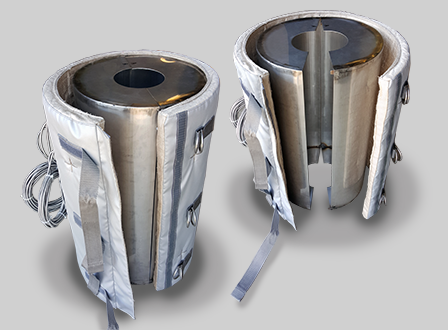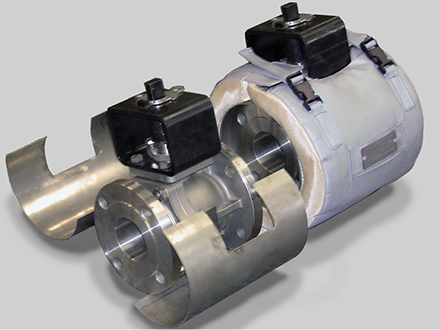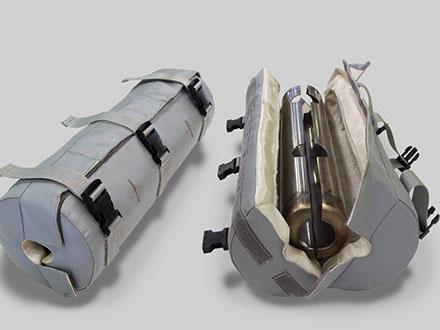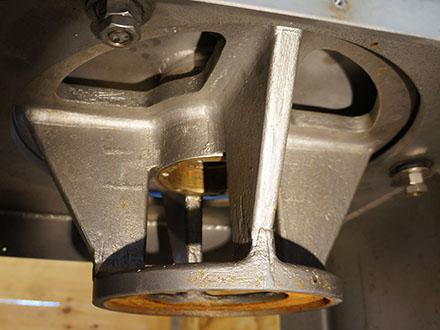ABOUT SLEEVED HEATING JACKETS
Sleeved Jackets are necessary when the Shaped or Tubular Heating Jackets are unable to fit a surface to provide direct heat transfer. Surfaces that are too complex for direct heat may be heated indirectly by introducing a metal sleeve. The uneven surface is then simplified to a geometry more suitable for Jacket fit. The indirect heat on the sleeve creates an “oven” like environment to heat devices such as valves, vessels or grouped instrumentation hardware. Since “oven” heat is indirect, it is slower and must use lower watt density heat.
Frequently Asked Questions
Temperature control mechanisms are recommended for all types of heating tapes. We provide temperature controls with heating tape systems to make one cohesive network, and we utilize existing controls. There are a variety of control mechanisms available and the best choice depends on the temperature, voltage, accuracy and output used in your system. A mechanical bulb and capillary thermostat are recommended for temperatures below 325 degrees F. For voltage control a variable transformer or solid-state Triac controller may be used. For precise temperature control you can activate from a bench-top or wall-mount, we recommend the BT-15 or WM-15. We supply a complete list of thermostats and similar mechanisms, and we are happy to help you select the ideal device for your needs.
Can I Leave the Unused Portion Rolled Up?
No, your heating tape will not function properly if it is not touching the heat sink from end to end. Rolled up heating tape can be hazardous, so be sure your heating tape is completely and properly installed.
How Can I Tell Which Side is "Up"?
Heating tape exhibits a uniform temperature on both sides. Either side of the heating tape may be applied to the heat sink.
Can I Cut Heat Tape?
No. Heating tapes utilize constant electric flow throughout and are designed for a fixed resistance at a given length and voltage. The tape is pre-designed to suit your environment and attempting to modify it will destroy the tape.
How Does Heat Tape Work?
Heating tapes utilize a constant watt density at a fixed resistance over a fixed length and voltage to create heat. Heat output is based on a given input voltage. Heat transference to pipes, floors and other surfaces occurs through direct contact with the tape. An insulator surrounding the enclosed heating element stops the heat from escaping and maintains a desired temperature. Temperature controls integrated into the circuit allow you to control the temperature.
Why Is Heat Tape Temperature Different in Some Places?
The materials inside the heating tape determine the operating temperature. Different heating tapes utilize different materials to create and maintain a desired temperature.
Can I Hook Heat Tape Up to a Thermostat?
Heating tapes effectively integrate with a wide variety of temperature control devices such as: thermostats, variable transformers, Triacs, solid-state digital temperature controls, programmable logic controllers (PLC's) or computers.
Why do I need different sized heat tape?
The size of your heating tape is determined by a variety of factors, including a proper mechanical fit, heat output, voltage and temperature rating, among others. Expert installers at HTS/Amptek® Company will help you select the correct heating tape size for your application to ensure optimal energy efficiency, safety and durability.
What heat tape sizes can I choose from?
HTS/Amptek® Company supplies a range of heating tape sizes to give you the best fit. Our heating tape sizes are available on our price list and online store. When choosing your heating tape, be sure to consider the heat output, voltage and temperature rating involved in your application. If you are not sure which size is best for you, contact us and we are happy to assist you.
Features and Specifications

| Power density: | 1.0 to 5.0 w/in² (0.16 to 0.8 watts/cm²) |
| Metal Sleeve: | Typical, 304 SS, 16 Gauge |
| Watts, Volts: | Custom KW, 120V/1 to 480V/3ph |
| Size: | Custom Modular Sizes for Convenient Install |
| Weight: | Modular, 50lbs (23kg) Max Recommended |
| Heat Capability: | Operating Temperature to 1000°F (538°C) |
| Max Exposure: | 1112°F (600°C) |
| Power Leads: | A Nickel or Cu-Ni, Flying, Sleeved or Armored |
| Power Plugs: | NEMA, Straight, Twist Loc, Pin & Sleeve |
| Sensors: | Process & Limit Thermocouple or RTD |
TYPICAL AND SPECIAL FEATURES
Jacket sizes:
Small Heating Jackets may be constructed to fit ¾ inch diameter tubing and fittings. Large Heating Jackets are limited by weight, typically 50lbs (23kg), but may be constructed in multiples to fit large surfaces.
Construction:
After the Sleeve is fabricated, The Jacket is constructed to fit the Sleeve. As with a standard Tubular or Shaped Jacket, an inner liner has the heater and sensor components. Heating Tape elements are mechanically stitched or bonded to the liner along with sensors and internal wiring paths. Then, insulation layers are placed over top with gussets and cut-outs necessary to enclose the sleeve. The Jacket is pre-formed to the 3D shape and double stitched for durability. The materials of construction depend upon the temperature and environment of use. Below 550° F choices can include materials such as Teflon and Silicone, which provide durability and some moisture protection.
Hybrid Design:
A system of different style Heating Jackets may be appropriate for a complex project. Sleeved Heating Jackets may be used for difficult geometries and Tubular, Flat or Shaped Jackets for the other areas. Contact your HTS/Amptek® for expert system heater and control application assistance.
The Heating Element:
HTS/Amptek® knitted Heating Tape is stitch bonded to the liner of each Jacket to apply the heat where needed. Monotape™ and Duo-Tape® elements are multi-strand insulated resistance wire, knitted into serpentine strips allowing ultimate flexibility that eliminates thermal stress.
Temperature Capability:
Maximum 1000°F (538°C), AMOX™ construction. Please note that AMOX™ is normally rated to 1400°F (760°C). Sleeves, having limited mass, may overheat if designed to typical high watt density values of (direct conduction) Tubular or Shaped Jackets. Reduced maximum temperatures are prudent to prevent high temperature excursions.
Heated Zones:
Typical Jackets have a single zone; however, multiple zones may be arranged having individual power leads and sensors. This arrangement can offer zonal duty-cycle for ultimate control.
Temperature sensors:
Built in thermal sensors such as RTDs or Thermocouples can be installed for process temperature measurement, or directly on the heating element for sensing limit temperature.
Cutouts and Penetrations:
Cut outs and slits for supports, ports and other hardware are typical of most applications. HTS/Amptek® designs pre-formed Sleeves and Jacket configurations with gusseted holes, slits and seams to provide great fit and easy install and removal. Additional, insulated flaps and straps cover the exposed seams.
Closures:
Most common Closures are Velcro® flap and D ring strap or lacing eye closure methods, however quicker and cleaner methods include convenient snaps or Delrin® Clips. Sleeves often are hinged or tabbed for easy alignment. The Sleeves typically fit on the heated envelope but “float” firmly within the Jacket.
Contact: HTS/Amptek®
Call or email your questions, or click the quote button for a convenient form to help us with the size and scope of your application.

















